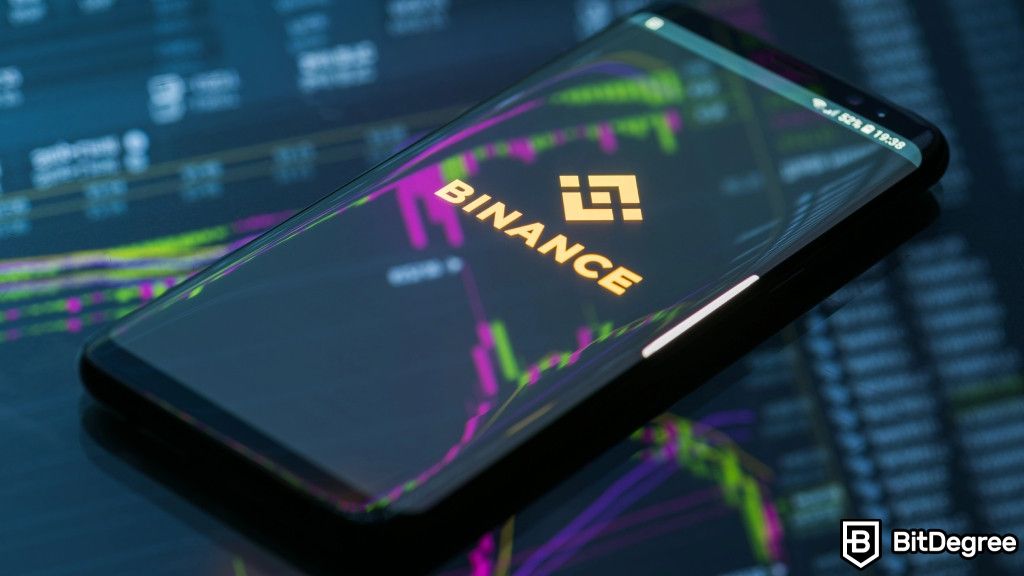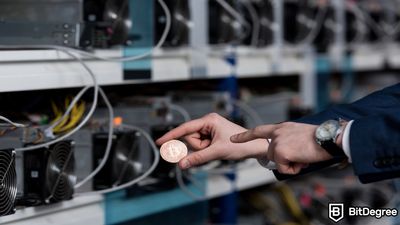Key Takeaways
- The options contracts offered by Binance are European style, meaning they can only be executed on the expiration date;
- Binance provides an intuitive options trading platform suitable for all skill levels, complemented by a robust educational resource base and the Easy Options feature;
- Binance Options fees are rather competitive, with a transaction fee rate standing at 0.3% and the exercise fee rate at 0.015%.
Stop overpaying - start transferring money with Ogvio. Sign up, invite friends & grab Rewards now! 🎁
In the realm of cryptocurrencies, Binance options trading emerges as a transformative force. To enhance accessibility, Binance has developed an intuitive platform tailored for investors of all proficiencies, challenging the notion that this trading method is exclusive to experts.
Further cementing Binance's stature as a premier crypto exchange, the options trading feature prioritizes delivering an exceptional user experience. It boasts user-friendly accessibility through both Binance's mobile app and web-based version.
The Binance Options platform distinguishes itself with competitive fees and minimal capital requirements, empowering traders to craft strategies aligned with their risk and reward assessments. That said, let's delve into the intricacies of options trading on Binance.

Did you know?
Subscribe - We publish new crypto explainer videos every week!
Candlesticks, Trendlines & Patterns Easily Explained (Animated Examples)


Table of Contents
- 1. What is Binance Options Trading?
- 1.1. Mark Price and Position Limits
- 1.2. MMP, Kill-Switch, BVOL, and Binance Options Calculator
- 2. Binance Options Fees
- 3. Pros and Cons of Binance Options Trading
- 4. How to Trade Options on Binance?
- 4.1. How to Set Up an Options Trading Account on Binance?
- 4.2. How to Place an Options Trade?
- 4.3. How to Monitor Your Orders?
- 5. Options Trading Tips
- 6. Other Binance Trading Methods
- 6.1. Futures Trading
- 6.2. Spot Trading
- 6.3. Margin Trading
- 7. Conclusions
What is Binance Options Trading?
Let's start with the basics – what is Binance options trading? Well, options trading is a derivative investment strategy where traders buy or sell contracts granting the right, but not the obligation, to buy or sell an asset at a predetermined price (strike price) within a specified time frame.
Latest Deal Active Right Now:Options contracts are usually used to speculate on price movements without committing to outright ownership of the underlying asset.
The Binance Options platform provides users with European-style options contracts. Such options allow holders to exercise the contract (buy or sell the underlying asset at the strike price) only on the expiration date. However, you can buy or sell the contract itself at the current market price anytime.
An alternative to that (which Binance does not offer) is American options, which allow the holders to exercise the contract any time before the expiration date. So, European options are less flexible. Nonetheless, most crypto exchanges support European-style options, not American ones.

Now, it's worth noting that Binance's design emphasizes user experience, aiding in the purchase and sale of these options contracts. It offers varied expiration dates and strike prices. Traders can also choose between Limit or Best Bid Offer (BBO) orders. The former sets a specific contract price, while the latter ensures immediate best market execution.
Also, Binance permits leveraging, allowing traders to hold larger positions than their funds would allow. While this amplifies potential profits, it’s also risky.
However, the maximum a buyer can lose is limited to the options premium, which acts as a buffer in volatile crypto markets. In contrast, a seller might lose their entire margin or face account liquidation. The premium is the price you pay (or receive) to buy (or sell) an options contract. Its value fluctuates based on market conditions and the expiration date.
Another vital concept regarding price is the settlement price – the price at which options contracts are settled upon expiration. This price is determined based on the average spot price of the underlying asset during a specific time window close to the contract's expiration.
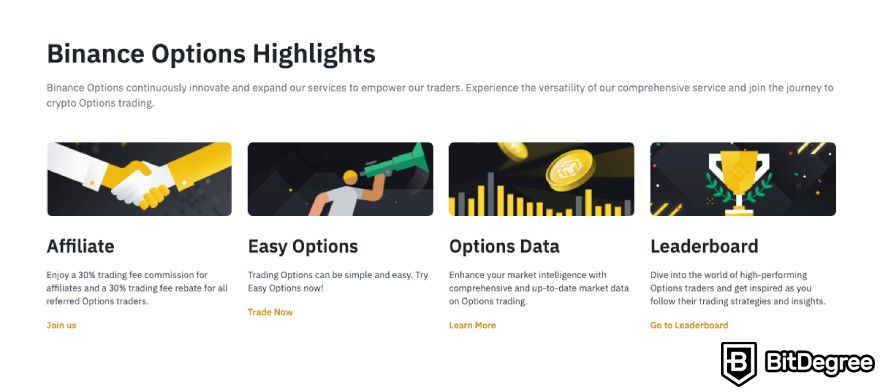
By the way, speaking of the whole buying / selling process, there are two more terms you must know – call option and put option. A call option is a fancier way of calling a buy option, which provides the owner of the contract the right to buy the underlying asset at a predetermined time and price. A put option, on the other hand, is a sell option.
For newcomers or those wanting a guided approach, Binance offers the Easy Options feature. This feature provides a streamlined guide to options trading, from contract selection to price trend analysis. Users can also search for contracts using filters, enhancing decision-making.
Accessing Easy Options is straightforward. Log into Binance, navigate to options, find the tools section, and click on "Easy Options". Then, just select a contract, predict the asset's price movement, and specify its duration. Based on these configurations, a customized list of options will appear. All that will be left for you to do is choose an option, input their amount, and confirm.
You can learn more about options trading overall in this article.
Now that we've covered the essence of Binance options trading, let's go a bit deeper and talk about the mark price and its relation to position limits.
Mark Price and Position Limits
In Binance Options trading, a key factor that shapes profit or loss is the mark price. This price, calculated using the Spot Index price, among other parameters, is essential for maintaining fair trading.
The options mark price also plays a central role in Binance’s risk management system. It is used to calculate the margin held against a position and any unrealized profit or loss on that position. Simply put, the mark price is what the system believes the options contract should be worth at a given time, based on current market conditions.
To keep this price accurate and timely, Binance constantly updates the options mark price using a formula known as the Black-Scholes model. A key component of this calculation is the "implied volatility", which the system derives from the best bid and ask prices for the Options contract.

This is further fine-tuned by volatility limits, known as caps and floors, which the system sets. It’s worth noting that during periods of extreme market movement, Binance may adjust these volatility caps and floors as needed and without prior notice to maintain market stability.
As an options contract approaches its expiration, especially during the final 30 minutes before settlement, the way its underlying price is calculated shifts. Specifically, during this 30-minute window, the underlying price is determined by averaging the Spot Price Index during that period.
In essence, the mark price is essential for fair trading and risk control on Binance. Its dynamic calculation ensures stability and reliability for traders.
MMP, Kill-Switch, BVOL, and Binance Options Calculator
When talking about Binance Options trading, there are three extra features you must know about – Market Maker Protection (MMP), Auto-Cancel All Open Orders (Kill-Switch), and Binance Volatility Index (BVOL).
MMP is a safeguard mechanism designed for options market makers on Binance. It allows market makers to withdraw their quotes under specific conditions, such as trading above a certain quantity within a defined time period.
By setting predetermined MMP Trigger parameters, market makers can automatically cancel existing open orders tagged as "MMP" if the executed quantity exceeds or equals a preset limit within a specified time window. This feature helps market makers manage risk by temporarily removing their exposure from the exchange, enabling them to reassess the market and adjust their order prices accordingly.
The Kill-Switch is another valuable tool for options market makers on Binance. It protects market makers from having open orders in the event of network disconnection. When activated, this feature automatically removes all open orders, including both MMP and non-MMP order types, upon detecting a network disconnection.
Market makers can set a countdown timer per underlying option, and if the server does not receive a heartbeat message within the specified time, it cancels all open orders associated with that underlying symbol. This ensures that market makers maintain control over their orders and mitigate potential losses during network disruptions.
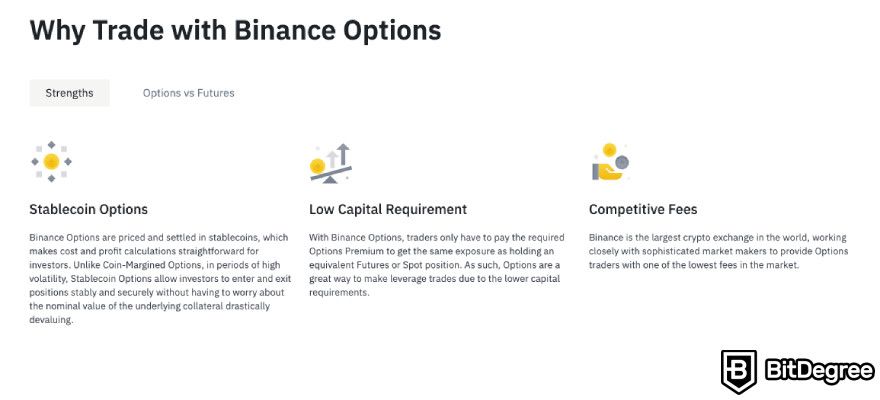
Moving further, BVOL is a derivative financial tool that measures the implied volatility of the cryptocurrency market, derived from the Binance Options market's crypto trades like BTC and ETH. It provides traders and investors with a real-time measure of the market's expectation of future volatility, aiding in market sentiment analysis, risk management, and decision-making.
The BVOL is calculated using a formula based on the weighted average of the implied volatility of specific crypto options contracts, considering options with different strike prices and expiration dates. Traders can access the BVOL on the Binance Options trading page, where it helps them gauge market sentiment and make informed trading decisions based on expected price changes.
Lastly, there's the Binance Options calculator or, to be more precise, the Options PnL (Profit and Loss) calculator. It's a versatile tool for evaluating potential outcomes of options trades. The Binance Options calculator considers essential parameters like the current price of the underlying asset, option strike price, premium, and option type.
It even factors in the time remaining until option expiry, recognizing the impact of time decay on option value. By inputting these variables, traders can gauge potential outcomes across different scenarios, empowering them to make informed decisions.
Binance Options Fees
There are two Binance options fees: transaction and exercise fees.
Opening or closing an options position incurs the transaction fee. This Binance Options fee is based on the underlying asset’s Spot Index price at order completion, with a cap at 10% of the option's value. The transaction fee rate stands at 0.03%, no matter if you're a market maker or a taker.
The formula for counting the transaction fee is the following:
Transaction Fee = Minimum (Transaction Fee Rate * Index Price * Contract Unit / 10% * Option Traded Price) * Option Traded Size
Meanwhile, the exercise fee applies when an option is exercised. Linked to the option's settlement price, it's also capped at 10% of the option's value. This Binance Options fee rate for exercising contracts stands at 0.015%.
The formula for counting the exercise fee is the following:
Exercise Fee = Minimum (Exercise Fee Rate * Settlement Price * Contract Unit / 10% * Option Value) * Position Size
Such fee structure underscores the commitment to affordable and transparent options trading in Binance.
Pros and Cons of Binance Options Trading
Before getting to the "How to trade options on Binance" part, let's go over the main pros and cons of Binance options trading.
PROS
✓ Versatility
Options trading offers a diverse range of strategies that cater to different market conditions and investor objectives. Whether the market is bullish, bearish, or moving sideways, options provide various ways to profit.
✓ The Possibility of Limiting Risk
One significant advantage of options trading is the possibility to define and limit risk. As you already know, when buying Binance options trading contracts, the most a trader can lose is the premium paid for the option. This upfront knowledge of potential losses provides a level of risk management that is not always available in other investment types, such as trading stocks outright.
✓ Leverage
Binance Options contracts enable traders to control a larger position in the market with a smaller amount of capital compared to trading the underlying asset directly. This leverage amplifies potential returns. For example, a relatively small movement in the price of the underlying asset can result in a much larger percentage gain in the option's value.
CONS
✗ Complexity
Options trading involves a steep learning curve and can be a bit complex for newbies. Understanding concepts such as strike prices, expiration dates, and various strategies requires time and effort. Though, luckily, Binance does provide the Easy Options feature and learning materials to simplify this process.
✗ Time Decay
Options contracts have a limited lifespan, and their value goes down over time due to a phenomenon known as time decay. As options approach their expiration dates, their time value diminishes, especially for options with shorter expiration periods. Time decay accelerates as expiration approaches, which can significantly impact the profitability of options positions, particularly for buyers of options contracts.
✗ Market Uncertainty
Options trading operates within a dynamic and often unpredictable market environment. The inherent uncertainty in financial markets, coupled with the complexities of options contracts, can pose significant challenges for traders. Market sentiment, geopolitical events, economic data releases, and unexpected developments can all influence asset prices and options values.
How to Trade Options on Binance?
Now, let's get more hands-on and talk about how to trade options on Binance. The first step is setting up a Binance Options trading account.
How to Set Up an Options Trading Account on Binance?
Step 1: Log into Binance or sign up, if you don’t have an account already. Just note that you must pass KYC to access Binance features.

Step 2: Once you're in, hover your mouse over [Futures] in the navigation bar and select [Options].
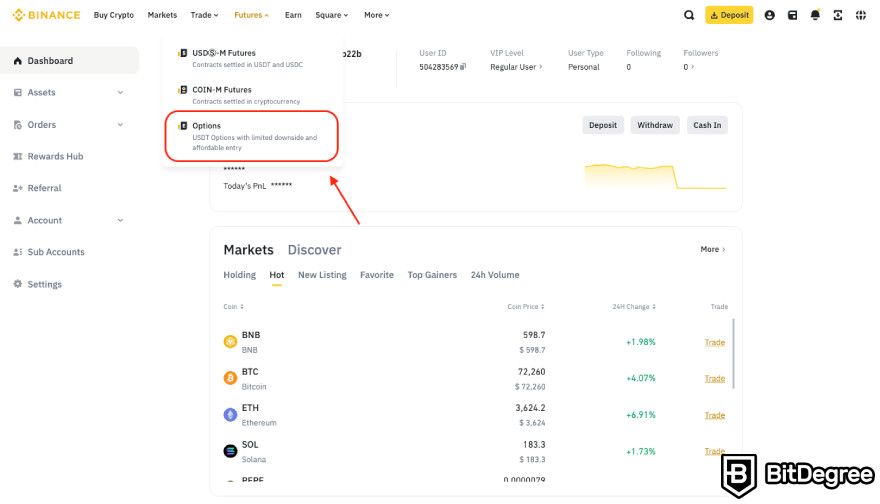
Step 3: In the newly opened Options trading window, read the Binance Options Service Agreement and click [Open Options Account] to initiate your account creation.
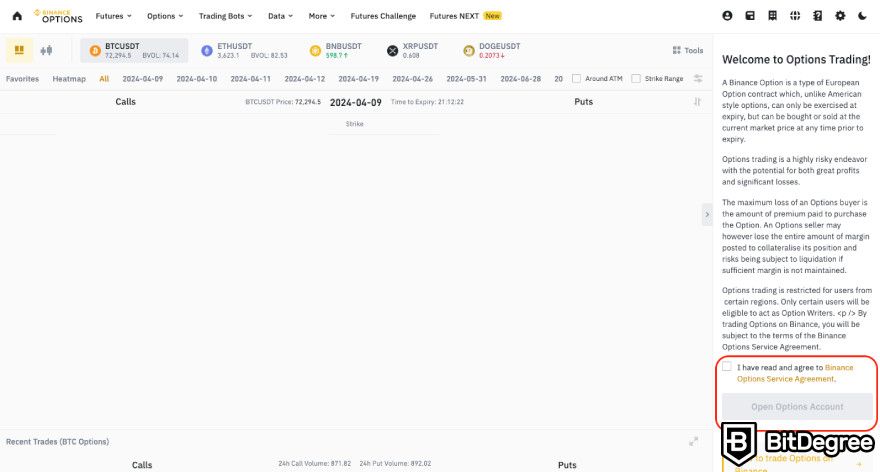
If you reside in a country where Binance doesn't provide derivatives services (or any services whatsoever), you won't be able to create an options trading account.
Step 4: An instructive tutorial on Binance Options trading will pop up. Go over the tutorial to learn all the essential things you should know about this feature.
Step 5: Once done, you'll be led to the market view, presenting all the actively traded options contracts and the order book.
How to Place an Options Trade?
Now that you have an account, we can get to the "How to trade options on Binance" part.
Step 1: Before buying, ensure your Options wallet is funded. You can deposit funds from your Spot wallet. To do that, hover your mouse over the wallet icon, and then click on [Spot].
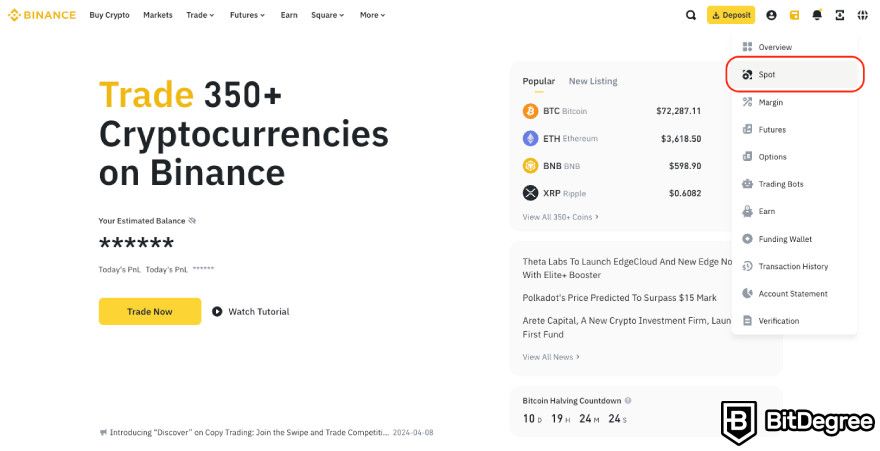
Step 2: Click [Transfer]. Then, choose the Options wallet as a transferring destination, specify the amount of the asset you want to transfer, and click [Confirm].
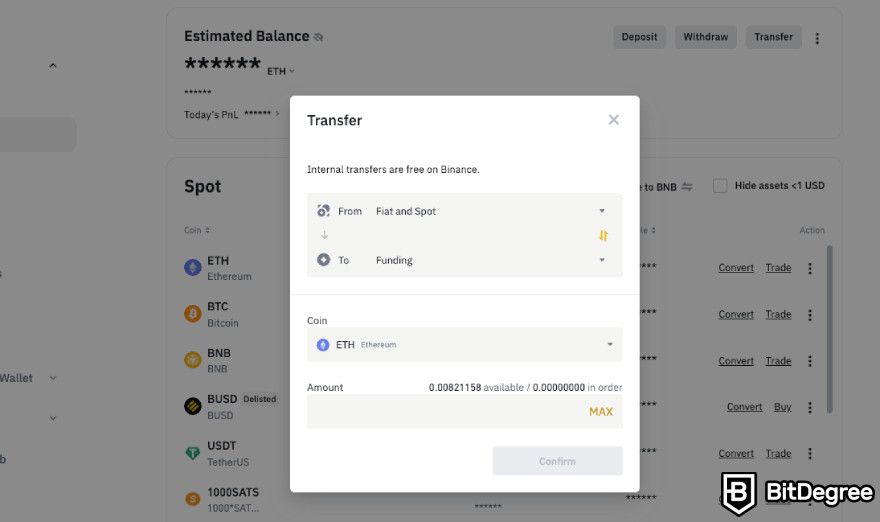
Step 3: Once the transfer is done, go to the options trading interface. To buy options, select your preferred underlying asset at the top left corner of the screen and then choose either a call or a put option (on the right side of the screen).
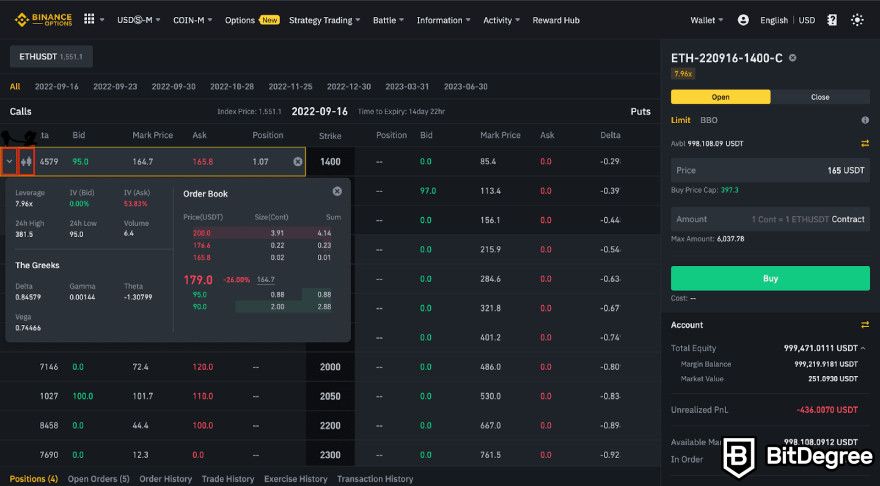
Also, choose the order type – Limit or BBO. The former employs the ideal ask price for buys or the top bid price for sales, while the latter lets you set a specific price. After determining the price and amount, click [Buy]. The required premium will be taken from your Options wallet.

Did you know?
Subscribe - We publish new crypto explainer videos every week!
What is Solana in Crypto? (Beginner-Friendly Animation)


How to Monitor Your Orders?
Managing orders and positions is key. The [Positions] tab lets you oversee open positions, revealing how much time remains before options expiry. Past data, such as order history, trade records, and transaction logs, are also accessible.

Besides, don't forget your Options wallet. You can access it from the trading interface's top right corner by clicking on the wallet icon. It also allows you to monitor ongoing positions.
That’s about it when it comes to Binance Options trading. You now know the basics of creating an options account, placing an order, and managing your activity. Following that, I also want to give you a few tips about options trading overall.
Options Trading Tips
Navigating the intricate pathways of options trading in Binance can be overwhelming, especially for newcomers. As you embark on your Binance Options trading journey, consider these important tips to ensure a seamless and prosperous experience:
- Understand the Basics. Before diving deep, ensure you have a solid grasp of options trading in Binance. Recognizing the difference between a call and put options, understanding the significance of the strike price and the expiration date, and being aware of intrinsic and extrinsic values are fundamental.
- Manage Your Risk. Options trading inherently involves risk. Set a clear budget for every trade and avoid investing money you can't afford to lose. Binance's feature of capping risks at the option's premium offers a safeguard, but it's crucial to employ judicious money management strategies.
- Stay Updated. Cryptocurrency markets are volatile and can shift rapidly. Stay ahead of news, technological advancements, and market trends.
- Diversify. Avoid putting all your capital into a single option. Diversifying across various options can spread risk and potentially increase opportunities for returns.
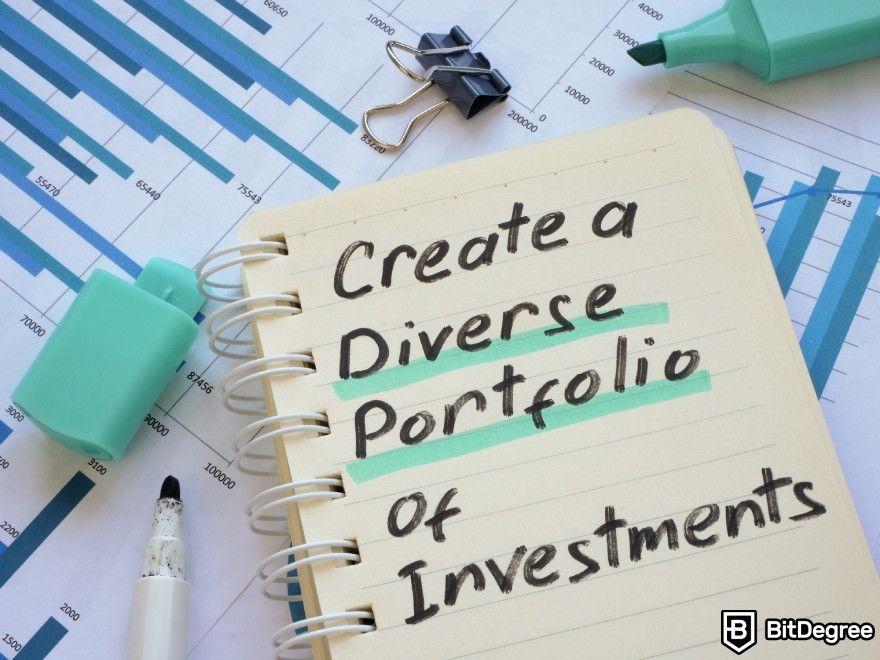
- Never Stop Learning. Binance offers numerous resources, including tutorials, webinars, and articles. Harness these tools to enhance your knowledge and refine your trading strategies. You can also check out BitDegree tutorials or, if you want to learn in a more exciting way, BitDegree Missions.
- Understand the Fee Structure. Always be conscious of the Binance Options fees associated with each trade. Even though Binance maintains a transparent and competitive fee structure, being mindful of these charges can aid in better profit calculations.
- Practice with a Demo Account. If you're a beginner, consider starting with Binance's Mock trading account, which provides a risk-free environment to familiarize yourself with the platform and practice strategies before diving into live trading.
- Review Regularly. Periodically review your trading strategies, profit-loss statements, and market insights. This retrospective analysis can offer invaluable insights, helping you refine your approach for future trades.
By following these tips and maintaining a disciplined and informed approach, you can enhance your confidence and proficiency in options trading.
Other Binance Trading Methods
Binance Options trading is not the only trading option offered by the platform. It also offers futures trading, spot trading, margin trading, and so on. So, let’s briefly go over the most popular alternatives to options trading.
Futures Trading
Binance futures contracts are agreements to buy or sell a cryptocurrency at a set price on a future date. While it sounds similar to options trading, it has one key difference – options contract holders have the right, but not the obligation, to execute the contract[1].

Futures contracts, on the other hand, are binding. Holders must abide by the agreement upon its expiration, risking significant gains or losses. For instance, if a trader predicts Bitcoin's price rise and it materializes by the contract's end, profits can be substantial. However, adverse movements lead to proportional losses.
Binance offers both quarterly and perpetual futures. Quarterly futures expire every three months, while perpetual futures do not have a set expiration.
Both futures and options allow for leveraging, granting traders exposure to assets at a fraction of the cost. This amplifies potential gains or losses.
Unlike options, futures don't experience time decay, where an option's value drops as expiration approaches. Also, while options need an upfront premium, futures can start without such a fee, though other costs may apply.
| Futures | Options |
|---|---|
| Give traders the obligation to buy or sell an underlying asset. | Give traders the right, but not the obligation, to buy or sell an underlying asset. |
| Risk is high as open oppositions can be liquidated. | Risk is limited to premium cost. |
| No upfront costs except for the transaction fee and funding rate. | Contracts require a premium payment in advance. |
| Futures contracts are resistant to time decay. | Options contracts become less valuable as the expiration date gets close. |
Table: Futures VS Options
All in all, futures and options, while offering similar crypto asset exposures, differ in trading mechanics and risk profiles. The preference between them depends on individual risk appetite, market predictions, and available funds.
Spot Trading
Now, another popular trading type on Binance (probably the most popular one) is spot trading, which essentially is the direct buying or selling of assets in what's known as the spot market. The distinguishing feature is the immediate delivery of the asset. Unlike futures, where you're agreeing on a future price for an asset, in spot trading, you're dealing with the asset's current (spot) price.
The primary motivation for spot traders is profit. They buy assets hoping their value will increase, allowing them to sell at a higher price later. But it's not just about buying; traders can also short the market. This means selling assets with the hope of buying them back at a lower price.
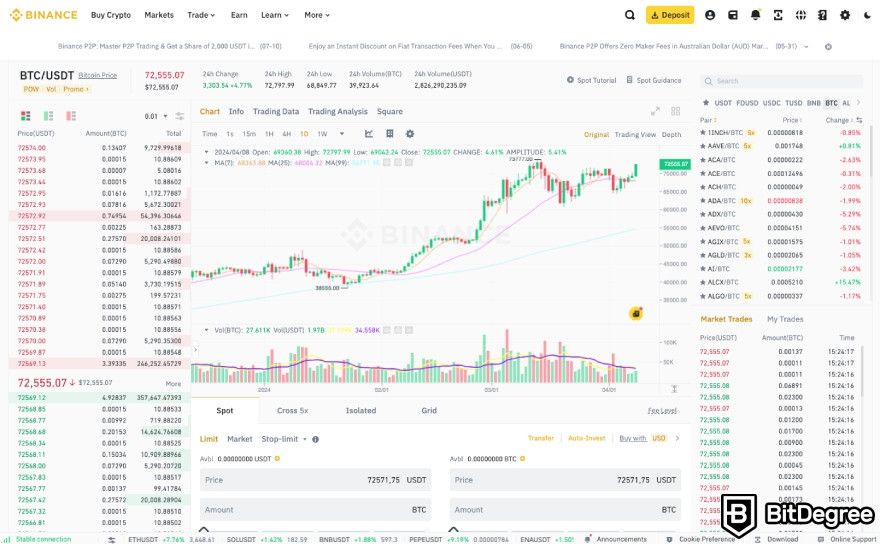
All this is driven by the spot price, which is the current market value of the asset. Spot prices are dynamic, updating in real-time as buying and selling orders match on the exchange.
Spot markets are simple yet have drawbacks. Their straightforward nature and transparent prices, driven by supply and demand, attract many, especially beginners. However, this simplicity might yield lesser gains compared to futures or margin trading.

- Secure and reliable
- Accepts fiat currencies
- Lots of trading options
- Reputable exchange
- Accepts fiat currencies
- Offers various trading options

- Huge trading variety
- Regulation-compliant around the globe
- Fair trading fees
- Beginner-friendly
- A wide array of features
- Vast number of different crypto coins & tokens

- Beginner-friendly
- Secure
- Decent trading and withdrawal fees
- Crypto.com Visa Card
- Automated tools & bots
- Ecosystem synergy with CRO
Margin Trading
Speaking of which, margin trading is closely related to spot trading. However, even though both exist in the realm of spot markets, the trading methods itself differ fundamentally. Spot trading necessitates the full purchase of an asset. In contrast, margin trading allows traders to borrow funds, enabling them to enter larger positions.
Margin trading is a potent tool for traders, allowing them to leverage assets using third-party funds. However, even though a successful trade can yield more significant returns, an adverse market shift can lead to larger losses[2].
Binance offers two margin trading modes: isolated margin and cross margin. So, why choose margin trading on Binance, though?
With Binance margin trading, users can leverage positions in popular cryptocurrencies like BTC, ETH, BNB, and USDT. Besides, it not only offers some of the best transaction rates but also ensures unparalleled transaction depth.
Conclusions
Binance Options trading is a hallmark of Binance's diversified trading offerings. With a user-centric approach, it has crafted a platform that is made for both beginners and experienced traders. Besides, Binance's dedication to continual learning is laudable, offering a plethora of resources to guide traders through the intricate world of crypto options.
However, every silver lining has a cloud. The lucrative opportunities within Binance Options trading come hand in hand with inherent market volatility. For traders, staying vigilant, understanding transactional nuances, and being aware of fees are pivotal to maintaining profitable outcomes.
Expanding the discussion, Binance boasts a versatile portfolio that includes other trading options, too, including futures, spot, and margin trading, each presenting distinct advantages and challenges. This variety ensures that traders have ample choices to fit their investment goals and risk preferences.
The content published on this website is not aimed to give any kind of financial, investment, trading, or any other form of advice. BitDegree.org does not endorse or suggest you to buy, sell or hold any kind of cryptocurrency. Before making financial investment decisions, do consult your financial advisor.
Scientific References
1. B. A. Goss, B. S. Yamey: 'Introduction: The Economics of Futures Trading';
2. J. Bian, Z. Da, Z. He, et al.: 'Margin Trading and Leverage Management'.
